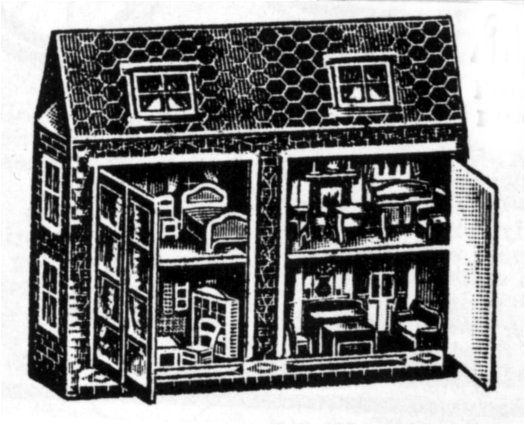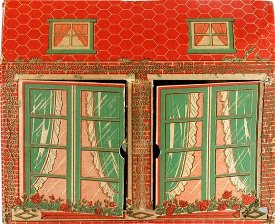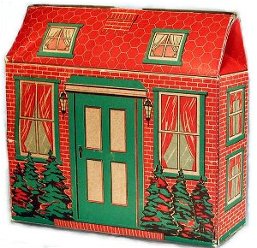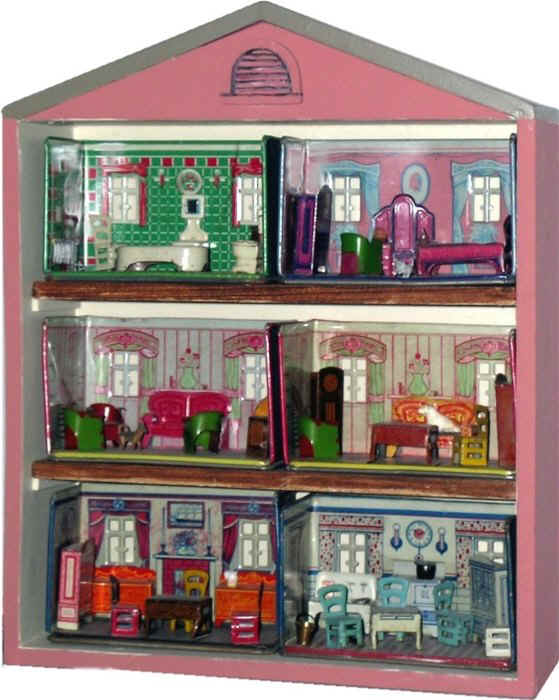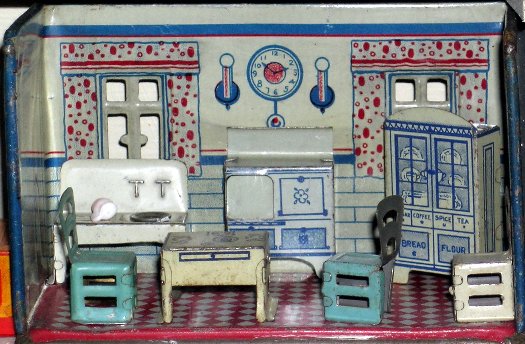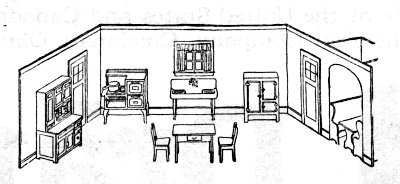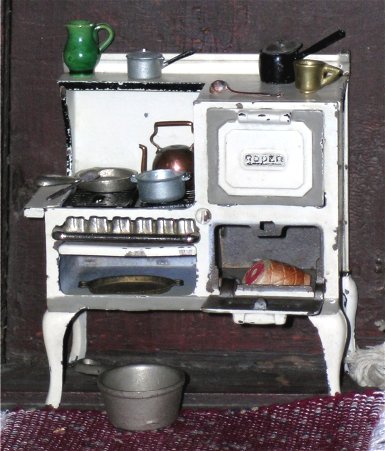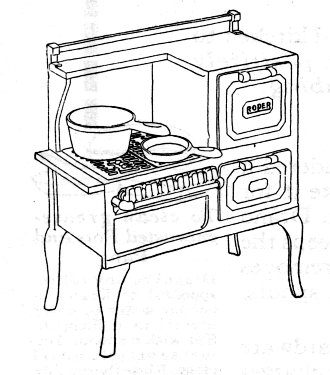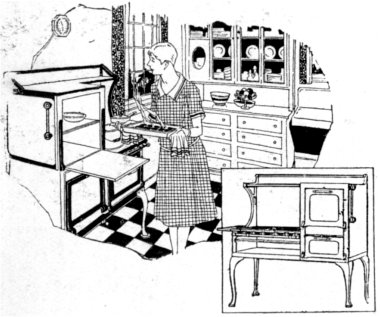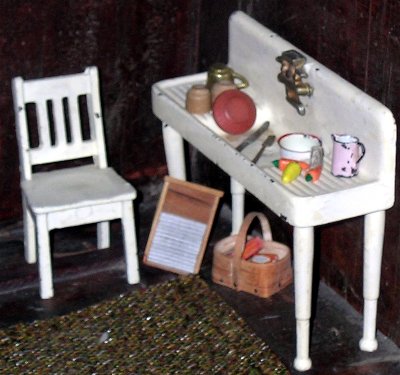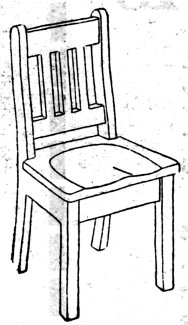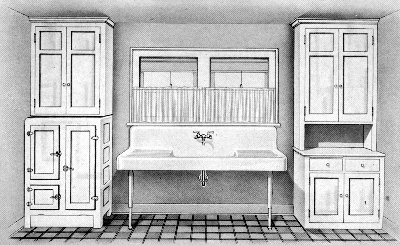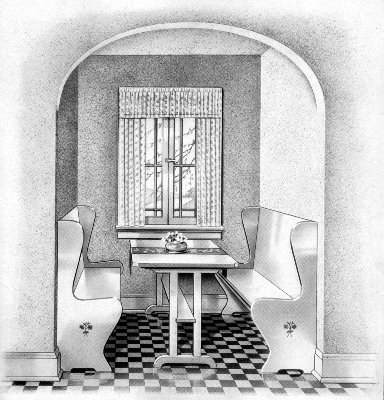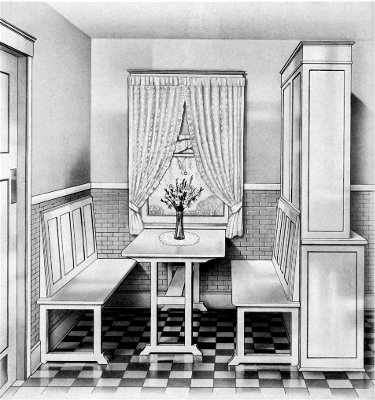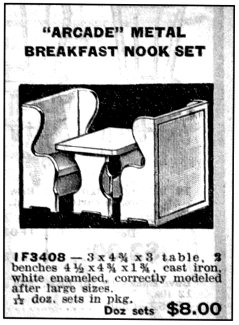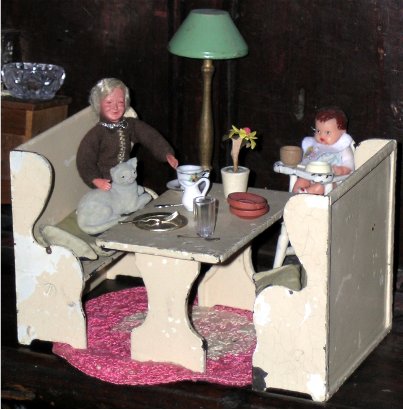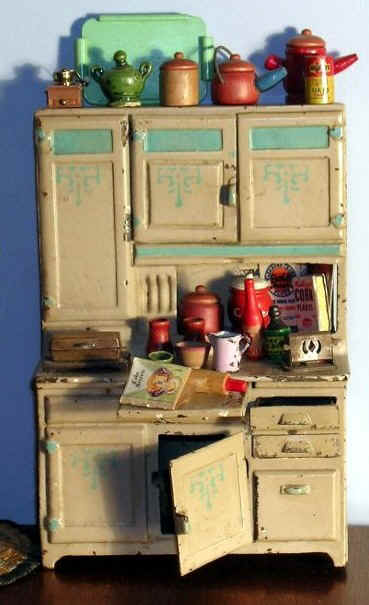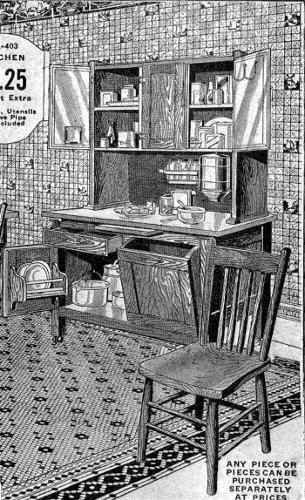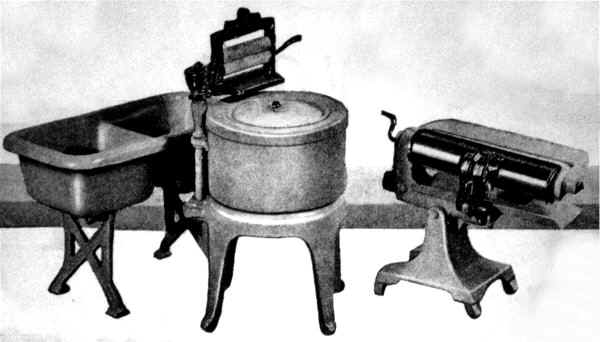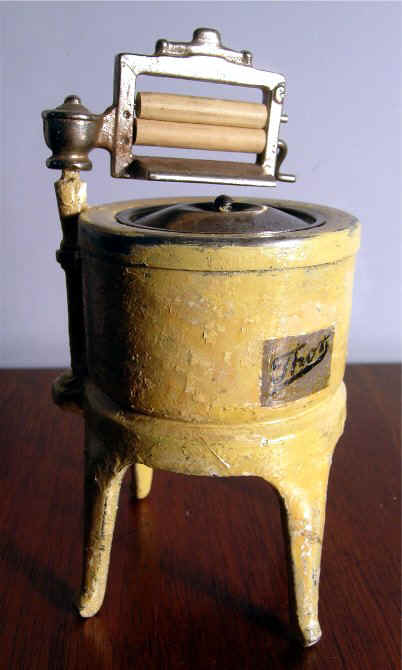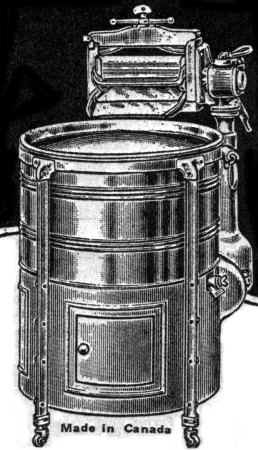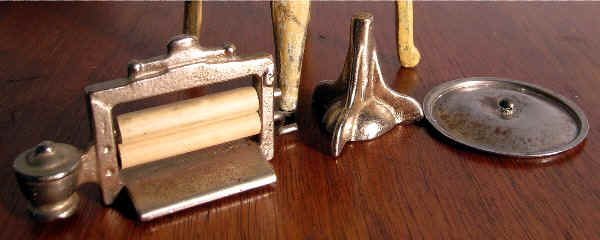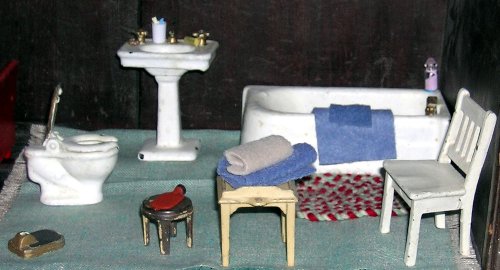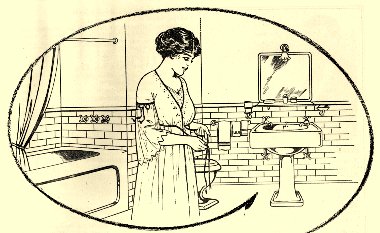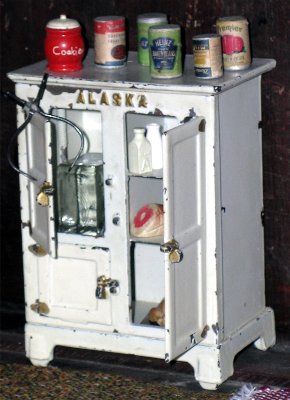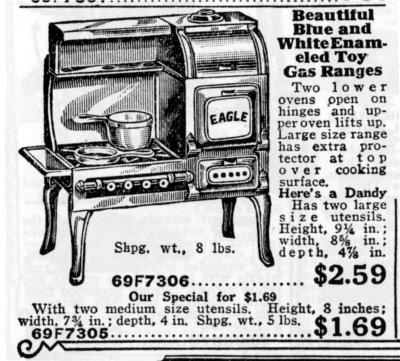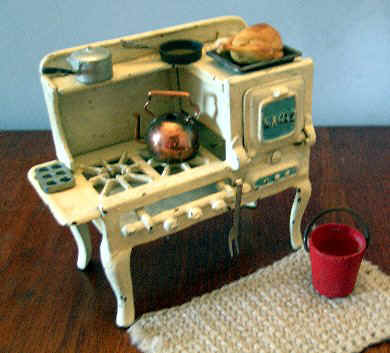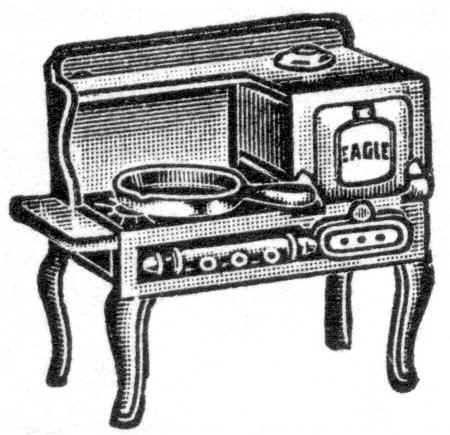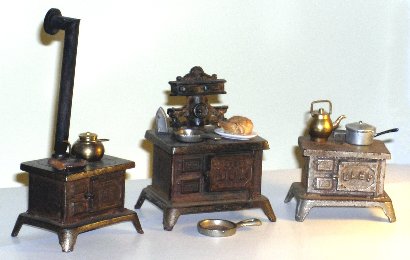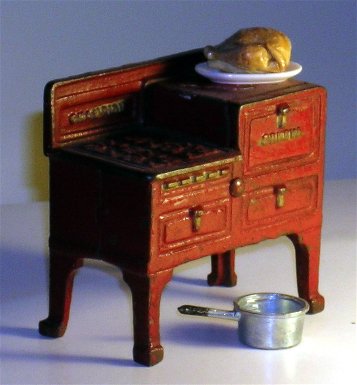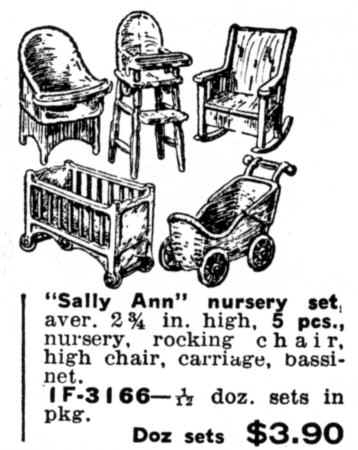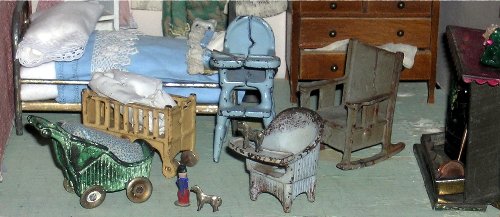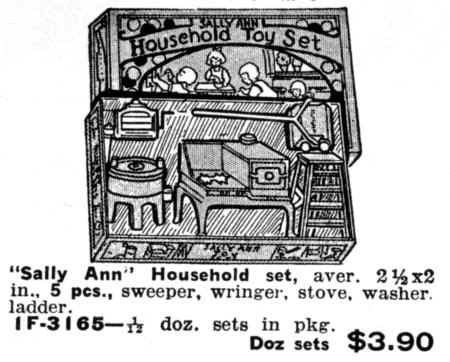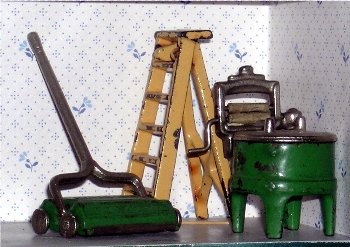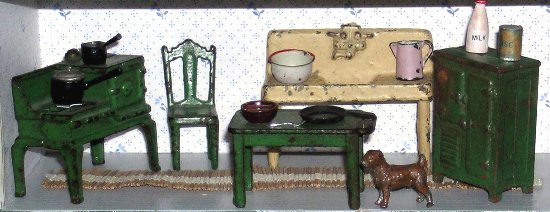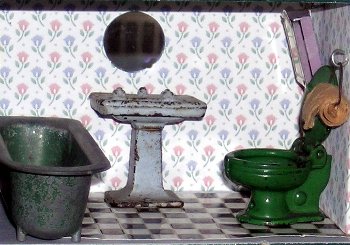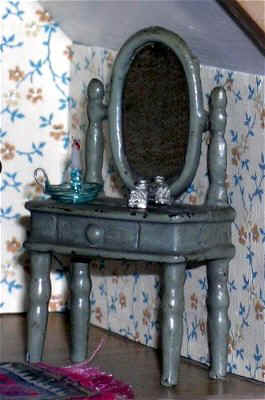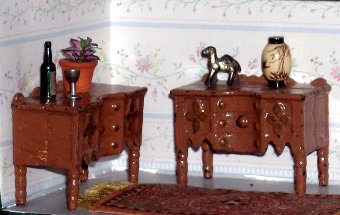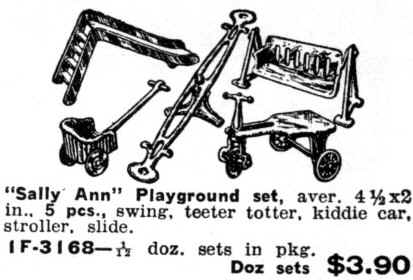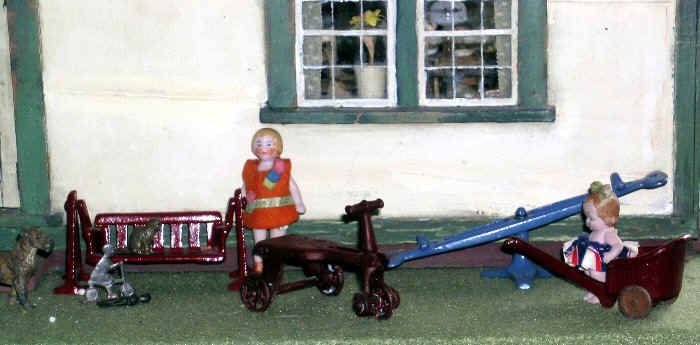home page 1890s 1900-1920 part 1: 1920s part 1: 1930s part 2: 1930s 1940s 1950s part 1:1960-1990 part 2: 1960-1990 A number of American dollhouse or dollhouse furnishings manufacturers, which began in the 1920s, continued strongly in the '30s such as Tootsietoy (discussed in part 1: 1920s), Arcade, Hubley, Kilgore (the latter 3 are discussed in this section), Converse (Realy Truly furniture), Tynietoy and Schoenhut (see 1930s). Others such as Strombecker (see 1930s) took off in the '30s and grew steadily in the 1940s. One of the interesting aspects of all their products is that they are not made from plastic, which belongs to a later period. An American metal set of furniture from the 1920s popular with today's collector -- and a decidedly visual contrast with Tootsietoy -- is Marx's Newlyweds furnished, lithographed, sheet steel rooms. The product is tiny in scale -- each metal room is 5 inches long by 3 inches high by 2½ inches deep. The bathtub is 2 inches long and the bed just under 2 inches (representing 6 feet). A child could buy six different individual furnished rooms in cardboards boxes or buy a furnished, colourful cardboard house, made especially for the purpose, but only holding four rooms (parlour, dining room, kitchen, bedroom) -- costing 44 cents, furnished and postpaid! In addition, a bathroom and library were made as individual boxed rooms. The furniture was relatively crudely constructed with tabs holding the metal together. The appeal is the ensemble of brilliantly coloured and decorated walls, floors, and furniture. Collectors should be aware that a German firm, Reil, Blechschmidt & Müller of Brandenburg, also made a similar sized set of 6 lithographed metal rooms with metal furniture at this time.
The illustration below of a Marx dollhouse is from the Sears Roebuck catalogue of 1930.
Arcade kitchen chair from an 1926 advertisement. The kitchen sink is 4.75 inches high with a place for hand soap on top of the taps.
The breakfast nook is another "dated" idea but very popular in the 1920s. It may have been cozy and reinforced the idea of family but likely was irritating in its inflexible arrangement of a pair of not easily moved benches drawn up to a table -- making hard for people to leave the table (no doubt Mom sat in one of outside positions so that she could hop up and down to serve!) and hard to clean. Building in an alcove added expense and might seem claustrophobic to some. The illustrations below from 1927 for real breakfast nooks (Universal Design Book No. 25 on Builder's Woodwork, Iowa), bear a striking resemblance to two of the Arcade sets -- one featuring curved bench ends (pictured below) and one with rectilinear lines (illustrated further below in kitchen setting). On the right, the nook area is simply distinguished from the rest of the kitchen by positioning a free-standing cupboard -- an arrangement a collector of Arcade miniatures might consider. Notice the floor tiles, as well as a wall dado with tiles.
Advertisement 1929 Butlers Brothers.
Arcade kitchen setting with breakfast nook alcove (compare the benches and table with the illustration of real ones from 1927 illustrated above) with original walls. The appliances are electric, a source of energy that became widespread in the 1930s.
Kitchen cupboards, here in a 1923 ad by Eaton's Canada, featured pull-out work-shelves, bins, drawers, counter space and storage areas; often in a natural wood such as oak. The metal Arcade cupboard (8" high), has a bin below the drawers and a pull-out shelf; the vertical device with slots under the upper cupboards likely is meant for plates; the painted decoration has a lingering Art Nouveau quality. The austere design of the kitchen chair sold by Eaton's echoes the plain appearance of the Arcade kitchen chairs.
right 1928
right 1928
Thor is a company, founded in 1907, which still makes appliances. It was part of the Hurly Machine Company of Chicago, which invented the electric washing machine in 1908 and patented it two years later. Arcade often used actual company brand names on its toys. Eaton's of Canada (immediately above right) wanted $85 for its real-life "Imperial Gyrator" in 1928 -- "simple, thorough, speedy, safe". The overall height was 4 feet -- making the toy version a large scale at 5½" high. Eaton's still offered a hand-operated washer made of cypress wood but, as we know from our vantage point, electric machines with metal bodies were the winners. Arcade's Thor (seen in an ad of 1928 above) came with a pivoting wringer, lid and detachable gyrator -- all appropriately made of metal (the winger has, as well, a pair of rubber rollers) covered in an attractive yellow ochre enamel paint. The Eaton's machine, covered on the exterior in gray enamel, had a copper tub, nickle-plated inside; the frame was angle iron; the base stamped steel; there was a heavy iron column enclosing the gears and working parts; the gyrator was aluminum; and the winger made of metal with soft rubber rollers.
Arcade toilet, sink, tub and chair c1930. The type of bathroom they suited is shown in real life in this drawing from Nov. 1917 American Builder. Tubs raised on feet were now considered old fashioned with "built-in" tubs now in vogue but pedestal sinks continued in the 1920s.
above 1930
above: Three small cast-iron, traditional, wood-burning cookstoves, made in the USA and definitely small enough for dollhouses. left to right: Tot by Dent (be wary of Tot reproductions), Dot by Shimer pre 1913, and Baby by Hubley. The latter is 2 inches high. The main door swings open in all three. Stove pipes and rings into a dollhouse chimney can be made with painted doweling and washers.
left: Made in Geneva, Ohio, by the Champion Company (pre the mid 1930s when they ceased to make toys), this small gas stove (left) is handsomely painted in red with gold accents. Standing 3.5 inches high, it is suitable for dollhouses. The doors do not open but there are openings for the four burners.
Located in Westerville, Ohio, the Kilgore Manufacturing Company made thousands of painted cast-iron miniatures before stopping the production of toys during World War Two. Dollhouse furnishings, known as "Sally Ann," were made in a variety of scales and a great number of purposes from step ladders to carpet sweepers to nursery sets to the usual household furniture.
above & left: The Kilgore nursery set, advertised in Butler Brothers in 1930. The "nursery chair" with a tray is a potty chair. Below is a household set from the same year. The laundry tub with its wringer is particularly sought after and difficult to find intact with the 2 rubber rollers and lid. The kitchen set includes a gas stove, ice box, table, chairs, and sink. The doors do not open. Outdoor items such as a lawn swing (see below) are interesting, as well as children's equipment such as strollers and trikes.
Kilgore playground set, painted iron, Butler Brothers catalogue of 1930
N.B. - to continue this history of dollhouse, please click on part 1: 1930s 1890s 1900-1920 part 1: 1920s part 1: 1930s part 2: 1930s 1940s 1950s part 1: 1960-1990 part 2: 1960-1990
|
